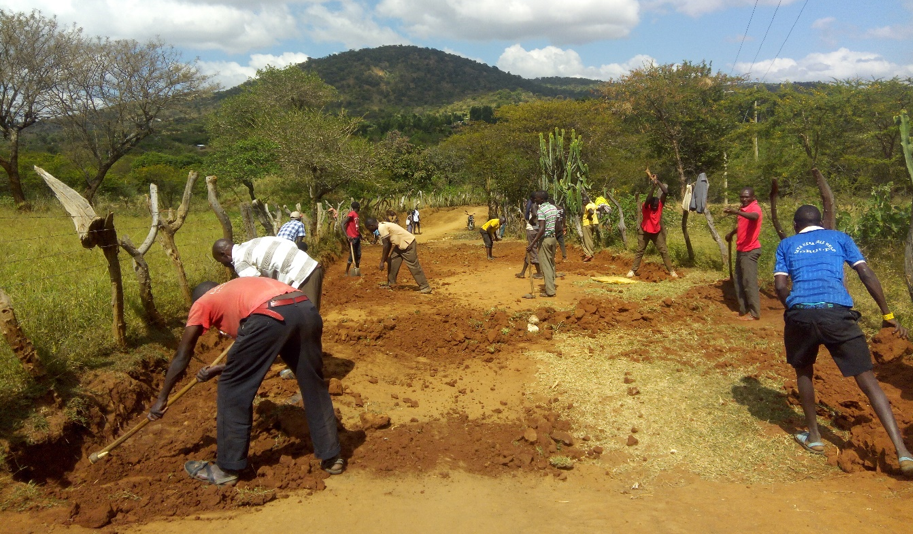
Drylands FRNs Working Together
Published on:
February 10, 2020
Community of Practice:
The drylands of West Pokot, Elgeyo Marakwet and Baringo suffer degradation due to soil erosion which is the result of biophysical and socioeconomic factors. While there have been many previous efforts at rehabilitation, these have been driven mostly by government/NGOs/researchers. These endeavors have borne some fruit, but for most areas, it has been short-lived.
CCRP, along with the lead organization, the University of Eldoret, and the partner organizations, the Kapkitony, Korellach Parak and Kaporowo Farmer Groups, began an initiative that seeks to engage and interest farmers and communities living in these areas to come together and restore their landscapes. This involved assisting farmers to form networks where their indigenous knowledge can be integrated with scientific information to provide sustained solutions to landscape degradation. Strong farmer research networks is key to not only restoring landscapes, but also to improve livelihoods of their communities.
The main goal of this initiative is to see these small holder farmers managing soil erosion of their farms through the use of appropriate soil and water conservation structures that will lead to improvement in sustainable crop and animal production in the area. Thus, if every farmer can utilize conservation skills that will help to reduce the amount of water flowing downhill, then the creation of deep gullies and decline in agricultural productivity will be addressed. This will ensure that surface water will infiltrate to recharge underground water, which with time will reduce the distance traveled in search of water for domestic use.
Terraces: The terraces constructed in the project areas have the capacity of intercepting 9,720 t of soil and 6,480,000 l of water. This is much more than the capacity of all the sand dams, making terraces one of the most effective interventions to reduce surface runoff and soil loss at the farm and landscape levels. Terraces were perceived by majority of the farmers to be more effective in controlling soil erosion and surface run-off than all the other measures installed.
Sand dams: By March 2019, the community had constructed a series of sand dams with a minimum volume of 937.69 m3 which would intercept at least 1,406.4 t of soil. Given the amount of soil already intercepted by the time the survey was done (1,139.4 t), sand dams had contributed to conservation of 821.8 kg of total nitrogen and 204,440 l of water in that season. Additionally, a total of 6.9 t of organic carbon was intercepted contributing to carbon sequestration in the ecosystem.
Benefits: Immediate benefits of the project to the community included:
- The regeneration of streams following the building of terraces and sand dams. This greatly reduced the distance traveled by members of the community, especially women, when fetching water for livestock and domestic uses. This resulted giving the farmers more time to pursue other activities.
- Improved crop production; where initially farmers used to report cases of seeds being swept away after planting, prompting them to replant, which is an activity that is expensive and time consuming.
- Grasses began to regenerate on fields that were previously bare, further stabilizing the landscape – particularly where terracing had been constructed.
Crop Impacts: The majority of the farmers agreed 100 % (n = 83) of the crops under trial had a good foliage growth habit and were drought tolerant, 96 % of the crops were disease tolerant and had an appealing taste, 93 % of the crops had a good height and could fetch good prices when sold, while 85 % and 82 % of the crops were perceived to be tolerant to pests and would provide good yields when harvested.
On assessing the perception of the farmer on the overall crop performance based on the test attributes:
- 100 % of the farmers agreed that beans, cow peas, millet and soybean are the best crop suited in their area.
- 85 % of the farmers concurred that dolichos, green grams, maize, pigeon pea and sorghum were suited to grow in the project area despite the field challenges affecting them such as pests and diseases.
- The highest ranking three crops, beans, maize and millet, proved very popular among the farmers with an approval rate of 74.3%, 13.6% and 5.7 %, respectively.